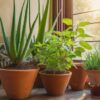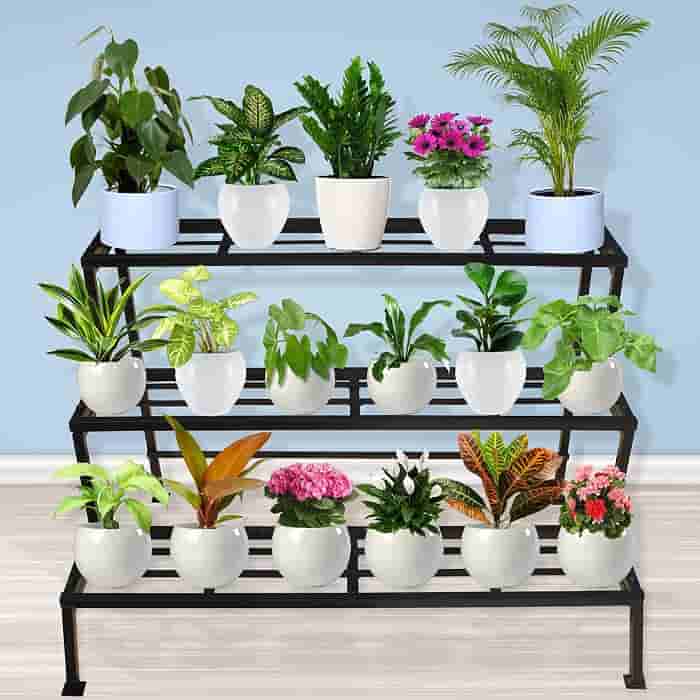In the bustling cities of India, where green spaces are often limited, indoor plants have become a popular trend among urban dwellers. Not only do they add a touch of nature to our living spaces, but they also offer numerous health benefits and create a serene and refreshing ambience. However, selecting the right indoor plants for your home can be a difficult task, considering the diverse climate and conditions across India.
Fear not! In this blog, we will take you on a delightful journey through some of the best plants that are sure to thrive in India’s varying climates.
Let’s Dive In!
Best Indoor Plants For Indian Climate
Areca Palm (Dypsis lutescens)
Known for its graceful appearance and air-purifying qualities, the Areca Palm is an ideal choice for Indian households. This tropical plant thrives in bright, indirect light and requires regular watering. The Areca Palm not only adds a touch of elegance to your interiors but also helps improve air quality by removing toxins.
Money Plant (Epipremnum Aureum)
The Money Plant, also known as the Devil’s Ivy, is a low-maintenance and versatile indoor plant. It can adapt to various lighting conditions, making it perfect for any corner of your home. Besides being aesthetically pleasing, the Money Plant is believed to bring good luck and prosperity, making it a popular choice among many households. In a superstitious way, it improves financial conditions.
Snake Plant (Sansevieria Trifasciata)
If you’re looking for a resilient and hardy plant, the Snake Plant is your go-to choice. It thrives in low-light conditions and requires minimal watering, making it ideal for busy individuals or those with less time for plant care. Additionally, the Snake Plant is known for its ability to filter out toxins, making it a perfect choice for bedrooms and offices.
Peace Lily (Spathiphyllum wallisii)
The Peace Lily is a beautiful flowering plant that adds a touch of elegance and tranquillity to any space. Indirect, bright light and moderate watering are good for it. The Peace Lily not only enhances the aesthetic appeal of your interiors but also helps improve indoor air quality by reducing the levels of harmful pollutants.
ZZ Plant (Zamioculcas Zamiifolia)
For those with a black thumb or limited sunlight, the ZZ Plant is a fantastic choice. It is known for its ability to tolerate low light and can survive in drought-like conditions. The ZZ Plant features glossy, dark green leaves that bring a touch of lushness to any room, making it a popular indoor plant across India.
Spider Plant (Chlorophytum Comosum)
The Spider Plant is a resilient and easy-to-care-for plant that thrives in a wide range of indoor conditions. It can tolerate both bright and Low light conditions and requires moderate watering. With its cascading foliage and ability to reproduce rapidly, the Spider Plant is not only visually appealing but also acts as a natural air purifier.
Rubber Plant (Ficus Elastica)
The Rubber Plant is known for its large, glossy leaves and is an effective air purifier. It’s a popular choice for adding a touch of greenery to living spaces and offices.
Plantation: Use a pot with drainage holes and well-draining soil. Place the plant in a spot with bright, indirect light and water when the top inch of the soil feels dry.
Tip: Wipe the leaves occasionally to remove dust and maintain shine. Fertilise every two months during the growing season with a balanced liquid fertiliser.
Aloe Vera (Aloe Barbadensis Miller)
Aloe Vera is a popular succulent known for its medicinal and skincare benefits. It’s an easy-to-grow plant that requires minimal maintenance.
Plantation: Plant in a well-draining cactus or succulent mix and a pot with drainage holes. Put the plant in a bright spot with indirect sunlight, and water sparingly when the soil dries out completely.
Tip: Overwatering can be the cause of root rot. Fertilise during the growing season once every two months with a balanced liquid fertiliser.
Boston Fern (Nephrolepis Exaltata)
Boston Ferns are popular for their lush, feathery fronds and air-purifying capabilities. They require a bit more care than other houseplants but are worth the effort for their beauty and air-cleaning abilities.
Plantation: Use well-draining soil and a pot with drainage holes. Place the plant in a spot with bright, indirect light and keep the soil consistently moist.
Tip: Mist the fronds regularly to maintain humidity, and trim any yellow or brown fronds. Fertilise during the growing season once every two months with a balanced liquid fertiliser.
Lucky Bamboo
Lucky bamboo is an excellent indoor plant to keep at home because it thrives without the need for soil. It survives being neglected for days, making it an easy maintenance plant. Many people consider lucky bamboo to be a true bamboo plant, but it is a species of tropical water lily called Dracaena sanderiana. Lucky bamboo holds a significant place as a popular Feng Shui plant, believed to enhance good luck and prosperity just like a money plant.
Jade Plant (Crasula Ovata)
The jade plant originates from South Africa and thrives in mild climatic conditions. Its fleshy leaves store water, and it acts as an excellent low-maintenance plant that filters indoor air. The woody stems contribute to its tree-like appearance.
Aglaonema Snow White
The Aglaonema snow white stands as a highly decorative plant and ranks among the most commonly used interior landscape plants. It represents the easiest of all house plants to grow, offering several intriguing varieties. While the varied types require greater light, the darker green varieties do well in close shade.
Croton (Codiaeum Variegatum)
Croton (Codiaeum variegatum) captivates with its stunning and vibrant foliage, showcasing a wide array of colours and patterns, including shades of green, yellow, red, orange, and purple. It adds a captivating splash of colour to any space, whether indoors or outdoors.
Crotons thrive in the Indian climate, adapting well to warm temperatures and high humidity. In addition to their aesthetic appeal, Croton plants purify the air, create natural privacy screens, and evoke a sense of tranquillity. Their ornamental value and adaptability make Crotons a popular choice for enhancing the tropical beauty of gardens, balconies, and indoor spaces in India.
It’s almost monsoon season in India and there are many benefits of growing Indoor plants during this season. Monsoon is a beautiful season, and everyone loves to enjoy it but it also comes with many issues like humid air and pest activities. Don’t worry! Indoor plants are strong enough to fight these issues. Let’s see them briefly.
Benefits Of Growing Indoor Plants During Monsoon
In the monsoon season, when the rain showers bring a refreshing and vibrant atmosphere, indoor plants actively provide several benefits that enhance our well-being. Let’s delve into the advantages of having indoor plants during this season:
- Improved Air Quality: Increased humidity levels during the monsoon season can create a favourable environment for the growth of mould and mildew. Indoor plants, such as Peace Lilies, Spider Plants, and Boston Ferns, actively act as natural Air purifying systems by absorbing toxins and releasing oxygen. In doing so, they improve the overall air quality in your home.
- Increased Humidity Control: Although excessive humidity can pose a challenge during the monsoon, certain indoor plants can actively aid in regulating it. Plants naturally release moisture through a process known as transpiration, effectively maintaining a balanced humidity level indoors. By incorporating plants such as Areca Palms, Rubber Plants, or Philodendrons, you can actively contribute to creating a more comfortable and healthier indoor environment.
- Stress Reduction And Mood Enhancement: Gloomy and rainy days during the monsoon season can occasionally impact our mood. However, indoor plants actively reduce stress, anxiety, and depression while promoting a sense of tranquillity and well-being. The presence of greenery and nature indoors uplifts your spirits and creates a positive ambiance, making the rainy days more enjoyable.
- Enhanced Aesthetics: Indoor plants actively enhance the beauty, colour, and vibrancy of any living space. In the monsoon season, when the outdoors may appear wet and dull, indoor plants effectively provide a refreshing contrast with their lush foliage and vibrant blooms. By adorning your home with plants such as Anthuriums, Orchids, or Bromeliads, you can instantly infuse your interiors with brightness and create a visually pleasing environment.
- Boosted Productivity And Concentration: Studies have demonstrated that indoor plants actively enhance productivity and concentration levels, making them ideal companions during the monsoon season when lethargy and laziness may set in. Having plants in your workspace or study area actively improves focus, creativity, and overall cognitive function, enabling you to remain productive and motivated even on rainy days.
- Connection With Nature: Don’t resist the urge to stay indoors when it’s pouring outside! Instead, embrace the beauty of nature by bringing indoor plants into your home. They offer a fantastic opportunity to stay connected with the natural world. Take pleasure in observing your plants as they grow and flourish. Show them care and attention, and witness the incredible cycle of life unfolding before you. It’s a fulfilling experience that reminds us of the captivating beauty that lies beyond those rain-soaked windows. So, let indoor plants be your gateway to nature’s wonders, even on the rainiest of days!
We know indoor plants have many benefits and we love them. Hence, it is necessary to take good care of them and keep them healthy. Here are some tips for you to make it happen.
Some Tips For Taking Good Care Of Your Indoor Plants And Keep Them Healthy
As a new plant parent, you might initially feel overwhelmed by the care required to keep your houseplants happy. However, the majority of your plants don’t demand constant attention to thrive. Besides regular watering, several low-maintenance houseplants only require minimal maintenance a few times a year. When it’s time to step in and prune or remove yellowing leaves, these tips will equip you with the confidence and knowledge to care for your plants effectively.
Watering Your Houseplants
Each house plant possesses distinct watering needs, influenced by factors such as their growth patterns and seasonal changes. Instead of following a rigid calendar schedule, it is advisable to water them based on their requirements. Typically, plants cultivated in well-drained potting mix and appropriately sized containers should be watered when the top 1/2 to 1 inch of soil feels dry. Keep in mind that cacti and succulents necessitate less water while flowering plants generally require slightly more.
One of the primary reasons for houseplant death is excessive watering. If you’re uncertain about the appropriate amount of water, it’s preferable to lean towards keeping the soil on the drier side rather than providing excess moisture to your plants. Moreover, when you do water, take care to avoid splashing water onto the leaves and stems, as this can promote diseases and lead to unsightly leaf spotting.
Fertilize Houseplants Periodically
Determining the appropriate amount of fertiliser to use for your plants is not a straightforward task. It varies based on factors such as the plant’s growth rate, age, and the current season. Typically, houseplants experience significant growth during spring and summer, making it the ideal time to provide them with fertilisers. However, during the shorter days of fall and winter, most houseplants require minimal or no fertiliser. To ascertain the correct dosage of plant food, refer to the instructions provided on the label.
Avoiding overfertilization is crucial, just like preventing overwatering, to ensure the health of your houseplants. Excessive fertiliser can harm their roots and hinder their growth. When it comes to flowering varieties, opt for a fertiliser where the three numbers on the label representing nitrogen, phosphorus, and potassium are relatively balanced. If the nitrogen content is too high, the plant may produce an abundance of leaves but have fewer flowers. Additionally, it’s advisable to choose a fertiliser that includes micronutrients to prevent any potential deficiencies.
Propagate Houseplants When Needed
Engaging in occasional propagation, whether through division or other methods, benefits various types of houseplants. It rejuvenates overgrown plants and stimulates new growth. Moreover, it presents a cost-effective approach to expanding your plant collection by obtaining new plants from the ones you already possess.
Certain houseplants, like bromeliads, produce fresh shoots or offsets at the plant’s base, making them suitable for division and transplantation into new pots. Climbing houseplants such as philodendrons and pothos develop new roots along their stems where they touch the soil, making them excellent candidates for propagating new plants from cuttings. Additionally, you can easily propagate new African violets from a single leaf by placing the stem end in water for a few weeks.
Additional houseplants, like spider plants and strawberry begonia, propagate by producing runners that develop new plantlets at their tips. Rooting these plantlets to initiate new plants is incredibly easy. Typically, you only need to soak the base of the plantlets in water for a few days, facilitating root development, before planting them in the soil.
Repot Overgrown Houseplants
Uncertain about whether your houseplants require repotting? Examine their root systems. If you observe roots that have formed a circular pattern inside the container, it might be an indication that repotting is necessary. If the plant has outgrown its current pot, you can transfer it to a slightly larger container. Alternatively, if you prefer to keep it in the same pot, carefully trim some of the roots using a sharp knife before replanting it with fresh potting soil.
While repotting your houseplants, take advantage of the opportunity to divide those with multiple stems, thereby creating new plants. The optimal seasons for repotting your houseplants are spring and summer.
Remove Dust From Plants
Regular cleaning enhances the appearance of nearly all houseplants. Leaves tend to accumulate dust, so give them a gentle shower of room-temperature water or use a soft brush to dust them if the plants have hairy leaves that can retain moisture and promote disease. For plants with smooth leaves, you can use a cloth to delicately wipe away any dust buildup. This not only enhances the plant’s visual appeal but also enables it to absorb more light effectively.
Deadhead Flowers And Remove Dying Leaves
To promote additional blooms and prevent the onset of disease, trim away faded flowers from your plants. Additionally, make sure to eliminate yellow, brown, or withered leaves. Utilise a narrow-blade hand pruner or sharp scissors to achieve a clean cut without causing damage to the plant’s stem. To prevent the spread of pests and diseases, it is advisable to wipe the blades of your pruners with rubbing alcohol before transitioning to a different plant.
Control Insect Pests
Houseplants often face attacks from various insects. You can effectively combat most soft-bodied pests, including aphids and spider mites, by utilising insecticidal soap. Another method is to use a forceful spray of water from the hose, which helps reduce the population of these pests. For insects with waxy coatings like scale and mealybugs, a practical solution is rubbing alcohol, which can be applied with a cotton ball.
Maintaining consistency is crucial regardless of the treatment method you choose. To effectively eliminate fast-reproducing pests like aphids and spider mites, it may be necessary to treat your plants once a week for approximately a month. This regularity ensures that the pests are completely eradicated.
Watch For Houseplant Diseases
To prevent the spread of diseases, take proactive measures by removing and disposing of any diseased houseplants, as well as affected leaves or stems, as soon as they appear. Since some diseases are transmitted by insects, it is essential to control the insect population to minimise the risk of disease. Be vigilant for common houseplant diseases such as powdery mildew (characterised by white powdery spots on leaves), fungal leaf spots (manifested as yellow, brown, or black spots on leaves), and root rot (indicated by dark, mushy roots typically caused by overwatering).
Conclusion
Bringing the beauty of nature indoors has never been easier, thanks to the wide variety of indoor plants that thrive in India’s diverse climates. Whether you’re a seasoned plant lover or a beginner, the plants mentioned above are sure to add a touch of green delight to your living spaces. Remember to consider the lighting conditions, watering needs, and space available when selecting indoor plants. So, go ahead, explore the world of indoor gardening, and create an oasis of greenery within your home. Happy planting!










Recent Comments